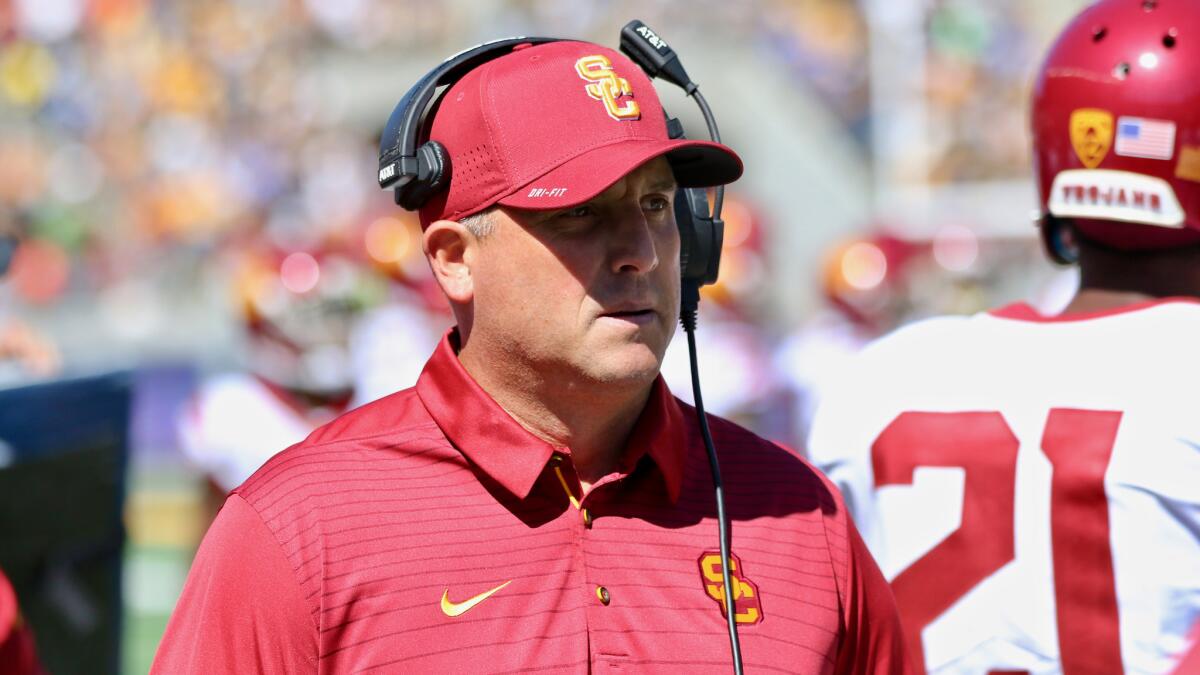USC mailbag: Playoffs? Don’t talk about playoffs

- Share via
Every week*, The Times’
*Hopefully
USC went more than a year without losing a game. So the team and their fans decided to use the Trojans’ first loss of the season, to
Kidding! Several players cried afterward. USC Twitter was on edge. The coaching staff was mostly defiant.
Let’s go to the questions.
If ever there was an appropriate time for this video, it is now:
In that spirit, duing last weekend’s podcast, I vowed to pump the brakes on playoff talk because, I said, USC needs to fix a lot of issues before it should even start thinking about making the playoffs.
I lied!
The people want playoff talk, so playoff talk they will get. Let’s break down USC’s chances in excessive detail. If you want to skip ahead to the next question, the short answer is: win out and USC will (probably) be in.
The long answer: There are a few factors to consider.
- What are the odds that the other four power conferences each produce an undefeated champion, which would effectively eliminate USC?
- What are the odds that no conference champion has two losses, which would mean USC isn’t a lock?
- And, if that happens, what are the odds that USC would lose the final spot to the other one-loss conference champions? (Let’s assume that a one-loss Pac-12 champion USC will make it in over a one-loss non-champion)
First, a warning, this will require some math.
For No. 1, I’m going to use ESPN’s Football Power Index. It’s imperfect, but it provides some solid odds that a team will win out. And it’s good news for USC: We almost certainly won’t see four undefeated power-conference teams. The probability is about 0.65% — not far off from the odds of drawing pocket aces in Texas Hold ‘Em.
No. 2 shows more good news for USC. Will we see no two-loss conference champions? Let’s look at history. I went through the conference standings for the five current power conferences over the last 20 years (I learned some interesting things. Maryland actually won the ACC in 2001. Who knew?) Turns out, it’s rare for all five conferences to end up with a one-loss champion or better. It’s only happened twice in 20 years, in 1997 and 2014. The most likely scenario, in fact, is that is that three conferences have champions with two losses or more.
Which brings us to No. 3. In the off chance that this is the one really funky season out of every 10, would USC be the odd team out? Maybe. There’s too many permutations to give any reasonable answer here. But USC hasn’t played well enough yet to inspire tons of confidence.
And that is kind of the point: If USC wins out, it’ll almost definitely make the playoffs. But USC has not played nearly well enough — at least not yet — to suggest it will win out.
And with that, I (seriously) won’t talk about playoffs for a while starting ... now.
Yes. Definitely yes.
USC didn’t complete any passes to a tight end last week and only attempted two. But that doesn’t mean USC doesn’t care about its tight ends. It means USC is really missing Daniel Imatorbhebhe, who is out with a hip flexor injury.
In fact, Imatobhebhe’s injury may be a significant reason USC’s offense is struggling. A very dangerous tight end makes it more difficult to bracket or shade Deontay Burnett in the slot, which would make the whole offense operate a lot better.
So yes, USC should still recruit tight ends. And USC would’ve liked to hold on to the ones it had, like Cary Angeline, a freshman who transferred earlier this season.
This has been one of the more popular (and persistent) questions this year — probably because USC has been bad in short yardage this season, where it has almost always used the shotgun.
So is the shotgun evil and bad?
Well, it does limit your options. Here’s one example. Imagine you’re the running back, lined up on the right of the quarterback in the shotgun. Now imagine you want to take a sweep outside of the right tackle. A little awkward, right? If you go to the left, no problem. You take the ball and keep heading in the same direction. To the right, though, you pause your momentum.
There are other plays that don’t work as well out of the shotgun, like, of course, the quarterback sneak. Also the naked bootleg run and anything involving a fullback.
But the shotgun does give you other options. Remember that awkward run from two paragraphs ago? That can actually be tweaked to use as an effective counter. There’s a popular thought on Twitter that the shotgun precludes a team from running power. It does not. And USC’s most effective short-yardage runs have been zone-read keeps by Darnold. USC scored twice on that play against Washington State. You can’t do that from under center.
So the takeaway shouldn’t be that the shotgun is evil and bad. It gives USC some useful tools in its offensive toolbox. It’s what USC practices most often and is most comfortable with, so it’s what USC should run most often too.
But refusing to go under center at all in short yardage has made the offense more predictable and easier to prepare for in short yardage. It shrinks the toolbox. And, pardon the extended metaphor, USC’s carpentry isn’t good enough right now to leave a bunch of tools at home.
USC looked like a top-10 team against
As for Tee Martin, offensive production has regressed, except for the Stanford game. I examined why earlier this week. In short, it’s a mix of everything: Bad execution, some play-calling issues and a spate of injuries. Whether that’s grounds for anger, and to whom you direct that anger, is up to you, I suppose. I’ll punt on that one.
Maybe!
Speaking of punting again...
Here’s the situation. USC has seen 21 punts that were not touchbacks. USC fair caught five of them. It returned four of them. Another one tipped off a blocker, which technically counts as a return, but really is just a fumble.
What that means is that USC is failing to even touch more than half of all fieldable punts.
I asked special teams coach John Baxter about that this week.
"Are you saying ‘fair caught’ or are you saying ‘returned’?" Baxter said.
"There's been a lot of punts that have just bounced and no one's touched it,” I said.
"Yeah, that's the nature of what happens in the kicking game these days,” he said.
What Baxter meant is that college teams have fallen in love with rugby punts, which allow more time for the coverage to get downfield. That means fewer returns. Rugby punts also tend to be lower, often designed to roll, which means fewer fair catches.
"We've had one punt that was returnable this whole year," Baxter said. It was in the Western Michigan game, he said, and Ajene Harris had to catch it over his shoulder.
The rise of rugby punts is accurate. But Adoree’ Jackson managed to return a fair amount of punts last season.
Baxter said what he cares about is field position. And if teams like Washington State want to sacrifice distance to prevent any returns, Baxter will live with that. He said he has dialed up the pressure, and that has led to even shorter punts.
But that is not wholly accurate. USC has improved in this area, and did particularly well in net-punt yardage against Washington State, but opponents have averaged 41.6 yards per punt against USC, 68th in the nation.
Baxter says don’t get your hopes up for big returns in the next two games either. He said he’d be surprised if USC returns just one punt.
Clay Helton said it was the doctors’ call, and the doctors signed off. USC had some experience here: JuJu Smith-Schuster had similar surgery on his hand, and he played, although the foot takes more of a pounding, and Smith-Schuster had an additional two days of recovery.
A halftime x-ray showed the screws in Gustin’s toes moved, so the doctors shut him down. But just as serious was Gustin’s biceps tear. Both injuries are keeping him out.
The replay shows it wasn’t really that close. And no one, including Darnold, argued. It was a fumble.
Usually, the officials review plays of such importance, but it’s likely that the booth looked at it and decided against reviewing. It wouldn’t have changed anything.
Here’s Martin’s explanation:
“I don’t know when you do it,” he said. “I mean, Western Michigan was close. When do you do it? You don’t learn against Stanford at home in a close game. It’s not the time to experiment.”
He’s right. If USC had thrown in a novice against Texas and then lost, fans would’ve been furious.
What USC could’ve done is identified Tyler Vaughns earlier. He had a nice camp and it is now clear he deserved more playing time early than he got.
Excitement scale
We went an entire mailbag a day before USC plays
Enjoy the game, everyone.
Twitter: @zhelfand
Go beyond the scoreboard
Get the latest on L.A.'s teams in the daily Sports Report newsletter.
You may occasionally receive promotional content from the Los Angeles Times.




